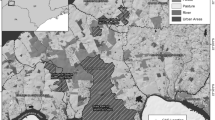Abstract
Bamboo forests are fast growing and renewable resources, and their carbon sequestration potential has attracted wide attention. Bamboo can be used for multiple purposes. Land expectation value (LEV) was estimated for various moso bamboo management models using the Faustmann–Hartman formula. Sensitivity analysis was also conducted to examine the impacts of carbon policy, interest rates, stem and shoots prices, and labour costs on LEV and management model choice. Two moso bamboo management models, one for stem production and another for stem and shoots production, were compared. Under current market conditions the estimated LEV per ha of stem bamboo plantations and for stem and shoots bamboo plantations were 48,454 and 51,292 CNY (Chinese Yuan. USD 1 = CNY 6.46 in year 2011) in the baseline year of 2011 respectively, and annual above-ground carbon sequestration potential of mature stands was 4.30 and 3.38 tons per ha, respectively. If carbon credits were available to growers, the LEV would increases and it seems likely farmers will be induced to expand the moso bamboo forested area, and convert some stem and shoots bamboo plantation into stem bamboo plantation, leading to greater carbon sequestration intensity. The LEV for stem and shoots bamboo plantations appears more sensitive to labour cost, while LEV for stem bamboo plantations is more sensitive to the price of stems. Low interest loans provided by the government to farmers or a carbon emission reduction credit trading system may help promote improved moso bamboo management.





Similar content being viewed by others
References
Belcher BM (1995) Bamboo and rattan production to consumption systems: a framework for assessing development options. INBAR Working Paper No. 4, INBAR, New Delhi
Buckingham K, Jepson P, Wu LR, Ramanuja Rao IV, Jiang SN, Liese W, Lou YP, Fu MY (2011) The potential of bamboo is constrained by outmoded policy frames. AMBIO J Human Environ 40(5):544–548
Chen XG, Zhang XQ, Zhang YP, Booth T, He XH (2009) Changes of carbon stocks in bamboo stands in China during 100 years. Forest Ecol Manag 258(7):1489–1496
FAO (2010) Global forest resources assessment 2010: main report. FAO Forestry Paper (FAO), no. 163
Guo QR, Yang GY, Du TZ, Shi JM (2005) Carbon character of Chinese bamboo forest. World Bamboo Rattan 3(3):25–28
Henley G, Lou YP (2009) The climate change challenge and bamboo: mitigation and adaptation. INBAR Technical Paper, INBAR, Beijing
Jiang PK, Meng CF, Zhou GM, Xu QF (2011) Comparative study of carbon storage in different forest stands in subtropical China. Bot Rev 77(3):242–251
Kuehl Y, Li Y, Henley G (2013) Impacts of selective harvest on the carbon sequestration potential in Moso bamboo (Phyllostachys pubescens) plantations. For Trees Livelihoods 22(1):1–18
Lobovikov M, Schoene D, Lou YP (2012) Bamboo in climate change and rural livelihoods. Mitigat Adapt Strateg Global Change 17(3):261–276
Ly P, Pillot D, Lamballe P, de Neergaard A (2012) Evaluation of bamboo as an alternative cropping strategy in the northern central upland of Vietnam: above-ground carbon fixing capacity, accumulation of soil organic carbon, and socio-economic aspects. Agric Ecosyst Environ 149:80–90
Marsh J, Smith N (2007) New bamboo industries and pro-poor impacts: lessons from China and potential for Mekong Countries. Enterp Dev Microfinance 18(2/3):216–240
Meng HY, Liu Q, Wu WG (2014) Study on the cost-benefit and carbon sequestration capacity of different management type’s moso bamboo plantation. J Zhejiang A&F Univ. doi:10.11833/j.issn.2095-0756.2014
Scurlock JMO, Dayton DC, Hames B (2000) Bamboo: an overlooked biomass resource? Biomass Bioenergy 19(4):229–244
Shibata S, Kumar A, Rao IVR, Sastry C (2002) Flowering of Phyllostachys pubescens and germination of caryopses. In: Bamboo for sustainable development, Proceedings of the Vth International Bamboo Congress and the VIth International Bamboo Workshop. San José, Costa Rica, 2–6 November 1998, pp 345–365
Tang XL, Fan SH, Qi LH, Liu GL, Guan FY, Du MY, Shen CX (2012) Effect of different managements on carbon storage and carbon allocation in moso bamboo forest (Phyllostachys pubescen). Acta Agric Univ Jiangxiensis 34(4):736–742
Watanabe M, Manabe I, Akai T, Ueda K (1982) Flowering, seeding, germination, and flowering periodicity of Phyllostachys pubescens. J Jpn For Soc. http://agris.fao.org/aos/records/JP8205984
Xiao FM, Fan SH, Wang SL, Xiong CY, Zhang C, Liu SP, Zhang J (2007) Carbon storage and spatial distribution in Phyllostachy pubescens and Cunninghamia lanceolata plantation ecosystem. Acta Ecol Sinica 27(7):2794–2801
Yen TM, Lee JS (2011) Comparing aboveground carbon sequestration between moso bamboo (Phyllostachys heterocycla) and China fir (Cunninghamia lanceolata) forests based on the allometric model. Forest Ecol Manag 261(6):995–1002
Zhou GM, Jiang PK (2004) Density, storage and spatial distribution of carbon in Phyllostachy pubescens forest. Sci Silvae Sin 40(6):20–24
Zhou GM, Wu JS, Jiang PK (2006) Effects of different management models on carbon storage in Phyllostachys pubescens forests. J Beijing For Univ 28(6):51–55
Acknowledgments
The authors wish to acknowledge the funding support from the Natural Science Foundation of China (Grants Nos. 71273245, 71203198 and 71073148) and the Talent Development Support Fund of Zhejiang Agriculture and Forestry University (Grant No. 2011FR001).
Author information
Authors and Affiliations
Corresponding author
Rights and permissions
About this article
Cite this article
Wu, W., Liu, Q., Zhu, Z. et al. Managing Bamboo for Carbon Sequestration, Bamboo Stem and Bamboo Shoots. Small-scale Forestry 14, 233–243 (2015). https://doi.org/10.1007/s11842-014-9284-4
Accepted:
Published:
Issue Date:
DOI: https://doi.org/10.1007/s11842-014-9284-4




